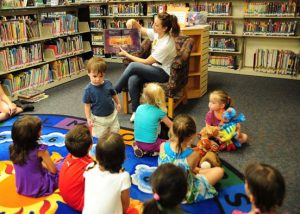
Going to the library with children fosters in them the desire to read. They learn to enjoy books at an early age which helps them when they begin school. It promotes concentration and attention span, especially in a quiet environment. They learn a respectful behavior of treating books in the library with care so that others can also get a chance to enjoy them. Children become responsible for books once they borrow them, they learn to return them when they are intact. It is important to read to children aloud once in the library to help them develop vocabulary and adopt the good utilization of language and skills that will come handy when they begin school. Reading to children gives them a good command of words by learning to check words through the dictionary. Learning new words is adventurous and exciting for children and it boosts their interest in knowledge. These books help children to learn about literacy fundamentals like how to associate words with pictures, how to hold up a book and turn the pages. It is imperative for parents to cultivate a culture of reading in children between 0-5 years old.
History of Mother Goose rhyme
This nursery rhyme books derives its origin from two sources. One from a book “Tales and
Stories of the Past with Morals” by Charles Perrault that was printed in the country of France in the year 1697. The second origin that is most popular is derived from a book by John Newberry “Mother Goose’s Melody” printed in the UK, in the year 1765.
Mother Goose who is always depicted as an old woman adorning a hat and shawl
has been used by various writers over time and has become famous among children
especially in their nursery rhymes. Mother Goose is often linked to ancient
legends like Bertha the spinner, the wife of King Robert II of France who got
her name for spinning incredible tales to children. Another theory is that of a
Bostonian wife of Isaac Goose who used to love singing songs to her
grandchildren and they would swarm around her to listen to her songs.
Skills learned through rhymes
Children learn language and literacy skills when they hear stories and listen to mother goose rhymes sung out aloud. They learn through facial expressions, actions, gestures, and sounds that help them to communicate better. Children learn to concentrate when their favorite rhyme is played. They develop physical skills as well as social skills through listening to rhymes. They also learn to exercise their creativity. These books have been around for a long time and they help children to laugh. They introduce them to
storytelling which helps them to develop language, learn to spell and read. Children
who enjoy reading improve their language and build their speech skills. Music and
rhymes have the power to increase spatial reasoning in children that help them
to attain mathematics skills.
Topics that children learn through rhymes
Children explore words that they can use to define weight, size and math-related concepts such as counting sequences that children will use to add and subtract. Mother Goose rhymes help children to explore story sequence to be able to know how the story flows.
Children learn to delve into volume, pitch, and voice to learn about the rhythm of language. Rhymes help to create an awareness of rhyming words and sound patterns of language
How parents and teachers can use rhymes
A Nursery rhyme is short and contains a lot of repetitions. They offer a child an opportunity to learn a tune over and over, thereby helping them to learn and remember sounds. A parent or teacher can use the rhyme of a song to teach children units of sounds. They can introduce patterns of sounds to the child helping their brain to learn to make words into syllables. Nursery rhyme books can instill the patience to listen and follow a narrative from the beginning to the end.